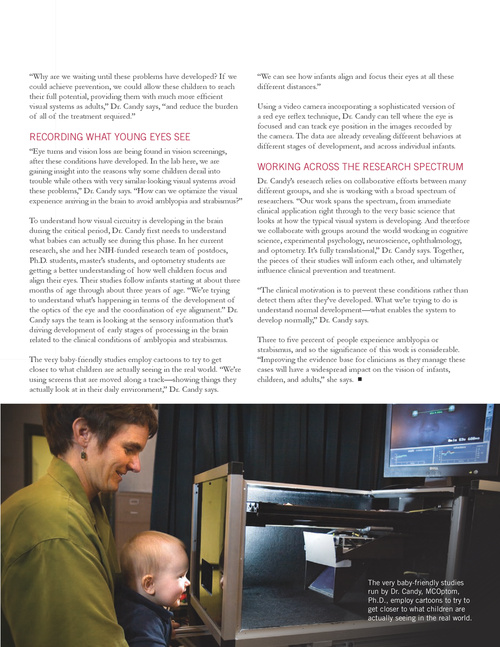
“Why are we waiting until these problems have developed? If we could achieve prevention, we could allow these children to reach their full potential, providing them with much more efficient visual systems as adults,” Dr. Candy says, “and reduce the burden of all of the treatment required.”
“We can see how infants align and focus their eyes at all these different distances.” Using a video camera incorporating a sophisticated version of a red eye reflex technique, Dr. Candy can tell where the eye is focused and can track eye position in the images recorded by the camera. The data are already revealing different behaviors at different stages of development, and across individual infants.
RECORDING WHAT YOUNG EYES SEE
“Eye turns and vision loss are being found in vision screenings, after these conditions have developed. In the lab here, we are gaining insight into the reasons why some children derail into trouble while others with very similar-looking visual systems avoid these problems,” Dr. Candy says. “How can we optimize the visual experience arriving in the brain to avoid amblyopia and strabismus?” To understand how visual circuitry is developing in the brain during the critical period, Dr. Candy first needs to understand what babies can actually see during this phase. In her current research, she and her NIH-funded research team of postdocs, Ph.D. students, master’s students, and optometry students are getting a better understanding of how well children focus and align their eyes. Their studies follow infants starting at about three months of age through about three years of age. “We’re trying to understand what’s happening in terms of the development of the optics of the eye and the coordination of eye alignment.” Dr. Candy says the team is looking at the sensory information that’s driving development of early stages of processing in the brain related to the clinical conditions of amblyopia and strabismus. The very baby-friendly studies employ cartoons to try to get closer to what children are actually seeing in the real world. “We’re using screens that are moved along a track—showing things they actually look at in their daily environment,” Dr. Candy says.
WORKING ACROSS THE RESEARCH SPECTRUM
Dr. Candy’s research relies on collaborative efforts between many different groups, and she is working with a broad spectrum of researchers. “Our work spans the spectrum, from immediate clinical application right through to the very basic science that looks at how the typical visual system is developing. And therefore we collaborate with groups around the world working in cognitive science, experimental psychology, neuroscience, ophthalmology, and optometry. It’s fully translational,” Dr. Candy says. Together, the pieces of their studies will inform each other, and ultimately influence clinical prevention and treatment. “The clinical motivation is to prevent these conditions rather than detect them after they’ve developed. What we’re trying to do is understand normal development—what enables the system to develop normally,” Dr. Candy says. Three to five percent of people experience amblyopia or strabismus, and so the significance of this work is considerable. “Improving the evidence base for clinicians as they manage these cases will have a widespread impact on the vision of infants, children, and adults,” she says. n
The very baby-friendly studies run by Dr. Candy, MCOptom, Ph.D., employ cartoons to try to get closer to what children are actually seeing in the real world.
9